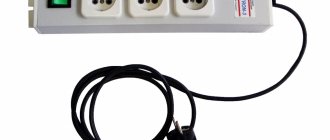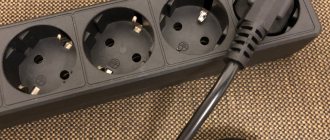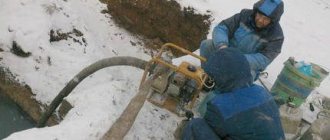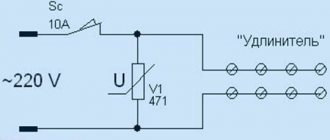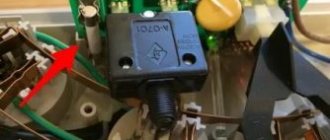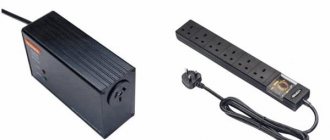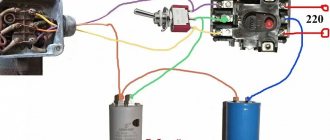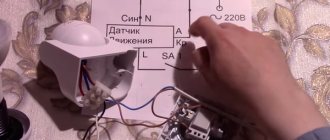What is a surge protector? - this is a relatively inexpensive device that protects quite valuable electrical equipment from current overloads, high-frequency and pulse interference, and abnormal voltage (high or low relative to normal).
The main task of the filter is to pass alternating current with a frequency of 50 Hz and a voltage of 220 V through itself, and completely block the way for any emissions. There are a great many outliers in the network, and they arise for various reasons.
For example, the refrigerator turned on, i.e. The start relay of his compressor has tripped. At the moment of switching on, the compressor (electric motor) consumes a current tens of times (20...40 times) higher than that indicated in the passport. At this moment, a “voltage sag” occurs in the network, followed by a surge (Fig. 1) - that’s a problem!
Even turning on ordinary light bulbs in a chandelier leads to seemingly imperceptible interference of the same nature. At the moment of switching on, they consume a current approximately 10 times higher than the rated current (while the coil is cold).
The most unpleasant thing is that the amplitude of the interference voltage can amount to hundreds, or even thousands of volts. This is quite enough to “burn” any sensitive device.
Rice. 1. Voltage followed by a surge.
How can this situation be prevented? This is where power surge protectors come into the picture! They are able to “swallow” all harmful surges of supply voltage.
To be fair, it should be noted that no power filter can compensate for slow voltage dips (voltage stabilizers are used for this purpose).
But the most dangerous for equipment is still impulse noise.
Schematic diagram
Figure 2 shows a typical power supply network filter circuit. It shows a three-wire (European) power supply network: “phase” - “zero” (“neutral”) - “ground”. Immediately at the filter input there is a varistor VR1.
Its task is to suppress high-voltage surges in the network. When such a surge appears, the electrical resistance of the varistor drops sharply, and it closes this interference through itself, not allowing it to pass further. Next, inductor T1 and capacitors C1, C2, C3 are included, forming an LC filter.
The resistance of the inductor increases with increasing frequency of the current, and the resistance of the capacitors decreases, so that all high-frequency noise is delayed or “drains” into the ground.
Interference can occur not only between the network wires (“phase” and “neutral”), they will be filtered by capacitor C3, but also between the “phase” and “ground”, and interference “neutral” - “ground” is also possible. To effectively suppress such interference, capacitors C1 and C2 are used.
Rice. 2. Typical power supply network filter circuit.
In the absence of ground, the common point of capacitors C1 and C2 “hangs” in the air, which leads to the creation by them and inductor T1 of a parasitic oscillatory circuit, which begins to emit a high-frequency electromagnetic field, becoming a source of potential danger for nearby radio equipment.
Rice. 3. Network filter circuit without grounded capacitors and connection to ground.
Therefore, in a two-wire network, filters are used without these capacitors and connection to the ground (Fig. 3). A typical amplitude-frequency response (AFC) of a network filter is shown in Fig. 4. From this graph it is clear that the higher the frequency of interference, the more effectively it is suppressed.
Rice. 4. Dependency graph.
It is worth dwelling on one feature of power filters. It will all be about the same “land”. There is a whole class of network filters in which the grounding wire has no connection with the internal circuit, except for the corresponding contacts of the Euro sockets themselves and the grounding contact of the Euro plug.
This achieves an important advantage: when operating from a grounded network, all filter sockets are grounded, as expected. But if there is no “ground” in the power outlet (a typical case of a domestic power supply network), all filter outlets are connected to each other via a grounding contact (naturally, the filter itself is not grounded). Why is it important?
Let's imagine, for example, a diagram of connecting various peripherals to a computer, shown in Fig. 5a (typical case - a printer, scanner, external audio amplifier, etc. are connected).
This is an ideal scheme: everything is connected to a grounded power supply network, the potentials of the device housings are the same (zero), since they are connected to ground. In the event of a breakdown or damage to the insulation of any of the devices, the “excess” voltage will go into the ground.
Rice. 5. Schemes for connecting various peripherals to a computer.
Now let's take a connection diagram for the case of a network without grounding (Fig. 5b). As you can see, there is no ground wire, and the only connection between the device cases is a low-current interface cable (more precisely, its braided shielding).
If there is a difference in potential between the computer case and the external device (and this happens all the time!), equalizing currents flowing from a higher potential to a lower one can easily “burn out” the input and output ports of the connected devices.
There are many such cases. The most common is the burnout of the input or output of the sound card if it is connected to an external signal source or to a sound amplifier.
To solve the problem, you need to connect these devices to a “European” extension cord, not even connected (for lack of it) to an external “ground” (Fig. 5c). Here, the electrical potentials of all devices are equalized, through currents will choose an easier path through the grounding contacts of Euro sockets, and nothing bad will happen.
Device
If we talk about the design of such a thing as a surge protector, then it should be said that it can belong to one of 2 categories:
- stationary-multichannel;
- built-in
In general, the circuit of a conventional surge protector designed for a voltage of 220 V will be standard and, depending on the type of device, may differ only slightly.
Other equipment also has such boards, which falls into the category of complex ones. Such boards usually consist of the following components:
- additional type capacitors;
- induction coils;
- toroidal type throttle;
- varistor;
- thermal type fuse;
- VHF capacitor.
A varistor is a resistor that has variable resistance. If the standard voltage threshold of 280 volts is exceeded, then its resistance decreases. Moreover, it can decrease by more than ten times. A varistor is essentially a surge protector. And stationary models usually differ in that they have several outlets. Thanks to this, it becomes possible to connect several models of electrical equipment to the electrical network through a surge protector.
In addition, all surge protectors are equipped with LC filters. Such solutions are used for audio equipment
That is, such a filter is noise suppressing, which will be extremely important for audio and working with it. Also, surge protectors are sometimes equipped with thermal fuses, which help prevent voltage surges.
Sometimes some models use disposable fuses.
Basic parameters of network filters
Cross-section of supply wires. Most often, a surge filter (Fig. 6) is produced with a core cross-section of about 0.75 or 1 mm2. This cross-section is considered sufficient since the maximum load current for which the filter is designed usually does not exceed 10 A.
A fuse is also installed for this current. If necessary, you can find a surge filter of increased power, the cross-section of the wires of which reaches 1.5 mm2. The fuse for such a device has a rated current of 16 A.
Rice. 6. Typical surge protector socket.
Length of the network supply wire. The standardized length of the filter power cord is 180 cm. For some models it can be 190 cm, 300, or even 500 cm. Number of sockets. Usually there are 4...6 of them (Fig. 7).
As a rule, all sockets have grounding “ears” (Euro type). There are filters with sockets of different types (1 - universal and 4, 5 - “euro”, Fig. 8).
Rice. 7. Set of sockets.
Number and types of fuses. Fuses are included in the network filter to protect against burnout of varistors in the event of large impulse noise and to disconnect consumers in the event of a short circuit or prolonged overload of the load circuits.
For greater reliability, some manufacturers, in addition to thermal fuses, also install self-recovering fast-acting fuses (based on metal-organic semiconductors).
The best extension cords from AliExpress
Extension cords are just sockets, but in a different design. They come with or without a power button. Models differ from each other in the degree of protection from dust and moisture, the number of mounting slots, the length and cross-section of the cable
When choosing an extension cord, it is important to pay attention to the quality of materials. Plastic elements should not support combustion and have high heat resistance. The best sellers of the AliExpress site indicate this information in the lot description
The quality of contacts is equally important. They are made of brass, which is a soft material that bends easily. So, the thicker it is, the more reliable the extension cord. All these points were taken into account when compiling the rating
The best sellers of the AliExpress site indicate this information in the lot description
The quality of contacts is equally important. They are made of brass, which is a soft material that bends easily.
So, the thicker it is, the more reliable the extension cord. All these points were taken into account when compiling the rating.
Filters
Designed to suppress interference. There are purely capacitive and inductive-capacitive ones based on LC circuits. Surge filter coils are available without cores or with ferrite cores (best on ferrite rings).
Additional devices. Indicators for switching on and the operational status of the protection on LEDs or neon bulbs glow when the filter (or its separate channel) is on and go out when the fuses trip. Arresters (gas) protect varistors at large amplitudes of impulse noise.
Any electrical appliance requires proper operation. There are also a number of safety rules regarding network filters. It is contraindicated to connect filters to each other.
Rice. 8. Example of a filter with Euro sockets.
This may unnecessarily increase the current in the ground wire. In addition, devices with high inrush currents (vacuum cleaners, air conditioners, refrigerators, etc.) cannot be connected to surge protectors. It is not recommended to connect surge protectors to uninterruptible power supplies as this may damage the protection circuits.
Review Reviews
According to buyers who purchased Era surge protectors, the beneficial and positive advantages of the purchase are:
- favorable and reasonable price with excellent quality of the device;
- the durable case of the product protects the internal circuits of the mechanism from damage, breakage and scratches;
- does not require certain storage conditions;
- safety;
- has in its set a maximum of functions necessary for the consumer;
- repairable.
When choosing a surge protector, pay attention to choosing devices from the Era brand. It guarantees time-tested quality for 15 years
The device is famous for its durability, long service life and reviews from numerous satisfied customers.
Review of one of the Era network filter models in the video below.
Purpose
Surge filters are presented on the market by various manufacturers of electrical products. The purpose of this device is to keep in working order devices and equipment powered by electricity during a possible power surge. A surge filter is a device that protects devices from power surges in the network; it looks similar to a simple extension cord, but a special unit can filter out interference and extraneous vibrations that are harmful to electronic devices.
Network filters
Surge filter - what is it, what is it for? Each household appliance has a passport, which contains requirements for the network from which it will receive electrical energy, in the Russian Federation this is a frequency of 50 hertz and the voltage necessary for the operation of the device or household equipment. What happens in practice:
- in every house there are residents who carry out repair work, use a welding unit or other electrical tools;
- there is a possibility of including some kind of production workshop in your line.
This is what leads to a failure in the supply of high-quality electricity to the consumer from the substation, which affects sensitive office equipment, as well as modern household appliances and televisions.
The normal operation of electrical devices should be graphically ensured by a smooth sine wave, but in practice it is more reminiscent of an cardiogram. A surge protector can filter out unnecessary harmonics and interference.
